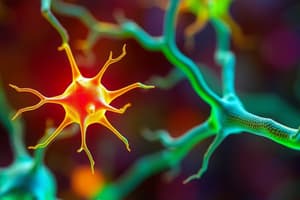Podcast
Questions and Answers
What is the role of ion channels in the generation of an action potential?
What is the role of ion channels in the generation of an action potential?
- Facilitate the flow of ions for rapid depolarization and repolarization (correct)
- Provide structural support to the neuron's axon
- Generate neurotransmitters for synaptic transmission
- Enhance the communication between neural circuits
What is the main difference between electrical and chemical synaptic transmission?
What is the main difference between electrical and chemical synaptic transmission?
- Speed of transmission
- Involvement of neurotransmitters (correct)
- Direction of signal propagation
- Type of ions involved
Which statement accurately describes an action potential?
Which statement accurately describes an action potential?
- It is only propagated through electrical synapses
- It is initiated when a neuron receives inhibitory signals
- It is a gradual change in membrane potential
- It involves both depolarization and repolarization phases (correct)
What is the primary function of neurotransmitters in synaptic transmission?
What is the primary function of neurotransmitters in synaptic transmission?
How do neural circuits contribute to neural signaling?
How do neural circuits contribute to neural signaling?
What is the role of voltage-gated ion channels in neurons?
What is the role of voltage-gated ion channels in neurons?
Which neurotransmitter is known for its inhibitory function in synaptic transmission?
Which neurotransmitter is known for its inhibitory function in synaptic transmission?
How do calcium (CaV) channels contribute to synaptic transmission?
How do calcium (CaV) channels contribute to synaptic transmission?
What is the main function of neural circuits in information processing?
What is the main function of neural circuits in information processing?
How do inhibitory neurotransmitters affect postsynaptic neurons?
How do inhibitory neurotransmitters affect postsynaptic neurons?
Study Notes
Neural Signaling: A Comprehensive Overview
Neural signaling, the process by which neurons transmit and receive information, is a complex and fascinating aspect of neuroscience. This process involves various subtopics, including action potentials, synaptic transmission, ionic channels, neurotransmitters, and neural circuits. In this article, we will delve into each of these subtopics, providing a detailed and factual account of the underlying mechanisms and their significance in neural communication.
Action Potentials
An action potential is an electrical signal generated by a neuron when it is excited. This signal is propagated along the neuron's axon, allowing the neuron to transmit information to other neurons or muscles. The generation of an action potential involves the rapid depolarization and repolarization of the neuron's membrane, which is facilitated by ion channels. These channels allow the flow of ions, such as sodium and potassium, across the membrane, creating a voltage difference that can be transmitted as an electrical signal.
Synaptic Transmission
Synaptic transmission is the process by which a neuron communicates with another neuron or a muscle cell across a synapse. This process can be either electrical or chemical. In chemical transmission, neurotransmitters, which are chemical messengers released from the presynaptic neuron, bind to specific receptors on the postsynaptic neuron, causing a response. These neurotransmitters can be either excitatory or inhibitory, depending on the type of receptor they bind to.
Ionic Channels
Ionic channels are integral proteins that span the plasma membrane of a cell, allowing the passage of charged ions. In neurons, these channels play a crucial role in generating action potentials and regulating the flow of ions across the membrane. Voltage-gated ion channels, such as sodium (NaV) and potassium (KV) channels, are responsible for the rapid depolarization and repolarization of the membrane during an action potential. Calcium (CaV) channels are also important, as they allow the influx of calcium ions, which can trigger the release of neurotransmitters from synaptic vesicles.
Neurotransmitters
Neurotransmitters are chemical messengers that play a central role in synaptic transmission. They are released from the presynaptic neuron into the synaptic cleft, a small gap between the neurons, where they can bind to specific receptors on the postsynaptic neuron. Some common neurotransmitters include glutamate, which is excitatory, and gamma-aminobutyric acid (GABA), which is inhibitory.
Neural Circuits
Neural circuits are networks of neurons that work together to process and transmit information. These circuits are formed by the connections between neurons, known as synapses. The strength of these connections can be modulated by various factors, including the release of neurotransmitters and changes in the properties of ion channels. This modulation allows for the fine-tuning of neural communication and is essential for learning, memory, and other higher cognitive functions.
In conclusion, neural signaling is a complex and intricate process that involves various subtopics, including action potentials, synaptic transmission, ionic channels, neurotransmitters, and neural circuits. Understanding these mechanisms is crucial for understanding how neurons communicate with each other and form the basis for various aspects of brain function and behavior.
Studying That Suits You
Use AI to generate personalized quizzes and flashcards to suit your learning preferences.
Description
Test your knowledge of neural signaling, including action potentials, synaptic transmission, ionic channels, neurotransmitters, and neural circuits. This quiz covers the mechanisms underlying neural communication and their significance in neuroscience.




